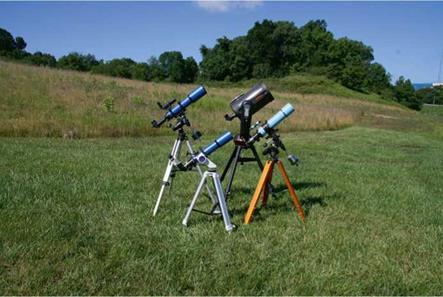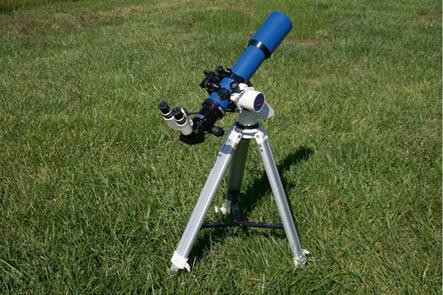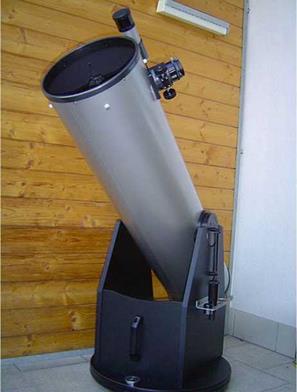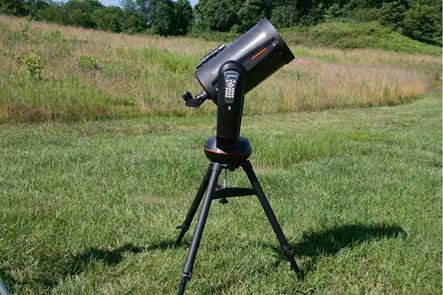The Filters
As the Moon waxes towards its full phase, the image through a telescope becomes uncomfortably bright. Not dangerously bright as with the Sun. Just so bright that the viewing can become difficult to identify areas on the Moon without squinting.
There are a number of filters available to telescope owners, such as nebula filters, light pollution filters, and color filters. These filters are very useful in many applications where the goal is to reveal very dim low contrast objects and features. But viewing the very bright Moon does not require these sophisticated accessories. The goal of using neutral density filters is to dim the light entering the eyepiece without any major degradation of image quality. With two polarizing filters, the same can be accomplished. By turning the filters in respect to each other, the amount of filtering can be adjusted.
It is recommended that one or two neutral density filters or polarizing filters be available to cut down the intensity of the incoming moonlight. These filters conveniently screw onto the bottom of the eyepiece. They cost less than $20, and are well worth the investment.
The Mounts
|
Fig. 2.16 The Author’s telescopes featuring an Alt-Az with Slow Motion Controls, two German Equatorials, and Computerized GOTO Mount. Courtesy of the author |
A solid telescope mount completes the total system needed for viewing the Moon, and beyond. There are two basic flavors of mounts: the altitude-azimuth mount, mostly referred to as the Alt-Azimuth or AltAz mount; and the equatorial mount. Each type can come either as manual, driven by hand controls or motors, and computer-driven GoTo models. Equatorial mounts and some computer-driven mounts compensate for the Earth’s rotation and will track the Moon, planet, or other celestial object, thereby keeping the object in the field of view of the telescope.
|
Fig. 2.17 AltAzimuth mount with slow motion controls. Courtesy of the author |
The most intuitive and easiest telescope mount is the altazimuth mount. Right – left and up and down. Simple in operation. In fact, it’s the perfect mount for young people to use. Four year old kids have been seen at star parties using a refractor on an alt-az mount viewing the Moon with little supervision. Altazimuth mounts are considerably lighter than equatorial mounts, and are therefore well suited for grab – and-go scopes or for traveling. No set up is needed. The main drawback is the lack of tracking. The observer manually adjusts the positioning of the telescope, becoming the human tracking motors!
|
Fig. 2.18 The Dobsonian Mount. Courtesy of Gary Hand |
A notable example of an alt-azimuth mount is the implementation made famous by John Dobson in the early 1980s. Known as the Dobsonian mount (with the entire assembly including the Newtonian telescope being referred to as the Dobsonian telescope), is a simple, low center of gravity alt-azimuth mount made of wood and Teflon bearings. The Dobsonian caused a resurgence in homemade telescopes in the 1980s and 1990s. In today’s market, telescope manufacturers dominate the 12-in. Dobsonian and smaller sizes because of the economies of scale. Larger sizes are economically attractive for homebuilt projects, and for those with the funds, can be obtained as commercially produced telescopes. The Newtonian telescope on a Dobsonian mount offers by far the biggest “bang-for-the-buck”. But they are big, bulky, and the Newtonian optics still requires frequent alignment. For Moon and planetary use, Dobsonians are not recommended for the mechanically challenged.
|
Fig. 2.19 German Equatorial Mount. Courtesy of the author |
With the exception of fork mounted Schmidt – and Maksutov-Cassegrains, the most popular form of equatorial mount in the amateur world is the German equatorial. The German mount is a tilted axis contraption with the right ascension axis pointed and aligned in the direction of the North Pole (for those down-under, the South Pole). A tracking motor applied to the right ascension axis drives the mount to keep the observed object in the eyepiece. German equatorial mounts are awkward and heavy. Care must be taken to balance the telescope on the mount, which explains the presence of the large counterweight that is a characteristic of the design. And polar aligning of this mount can be a chore. But if astrophotography is a goal, the German mount is a necessity.
|
Fig. 2.20 Computer GoTo Mounted Schmidt-Cassegrain. Courtesy of the author |
A GoTo telescope mount is quite simply a telescope system that is able to find celestial objects in the night sky, and then track them. The GoTo mount can be set up in an alt-azimuth or equatorial fashion, and after the proper alignment procedure, the finderscope is not needed for the rest of the evening. Some of the newer GoTo telescopes have electronics that will perform the alignment procedure automatically.
These telescope mounts are wonderful pieces of technology. The GoTo technology allows for more efficient use of observing time by quickly finding objects in the night sky. Built into the hand controller is a microprocessor, firmware, and built-in memory catalog of the positions of thousands of stars, galaxies, nebulae, open star clusters, globular clusters, planetary nebulae, our solar system planets, and of course the Moon. And the Moon is the one object that does not need a computer assist to find.
There is a tradeoff when buying a GoTo mount. These mounts are not cheap. Often consumers are faced with the dilemma of either a smaller telescope with a GoTo mount, or a larger aperture telescope on a non-computerized mount. In the case of viewing the Moon, a GoTo mount is not needed. If you can’t find the Moon, it’s either during the new moon phase, or you’ve got other problems! The Moon is an easy target.
A tip to GoTo owners: When using a telescope on an alt-azimuth GoTo mount, always use Polaris as one of your alignment stars. The computer algorithm used in programming the mount goes through less mathematical gymnastics when aligning with declination 0°, right ascension 0°. The GoTo accuracy is improved tenfold.















